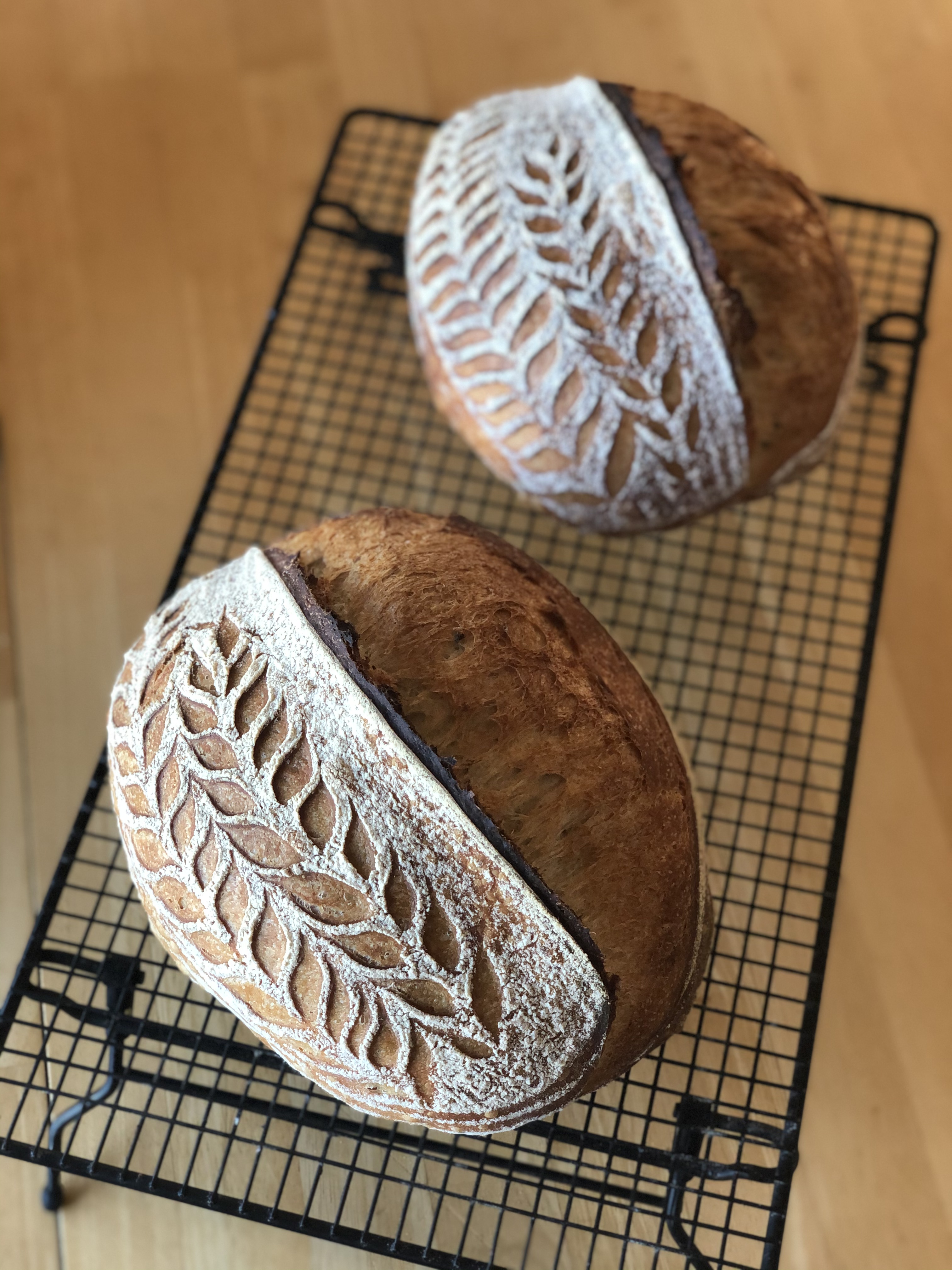I will never forget my first successful loaf of sourdough baked in our tiny home. It was 2016, and we were wrapping up shooting our Tiny House Nation TV episode. I pulled the loaf out from the oven, in shock at its beauty, and within minutes it was gobbled up by Justin & THN staff. Ha! Since then, I’ve watched hours and hours of youtube videos on sourdough, and have gathered tips and tricks along the way to help with success baking your loaf. I’ve also just made up some hacks that help and want to share them all with you.
Here I breakdown my process with a time table as well to get a general idea when I approach each step. Note that this is a pretty darn flexible process so you don’t have to strictly stick to the others listed below. Let’s dive in!
Video Sourdough Breakdown:
This video is a great starting off point, giving our step-by-step breakdown of what we do to prepare our loaves. All the written instructions can be found below as well.
Sourdough Bread Baking Materials
There’s just a couple items that I’ve found to be must-haves in the sourdough making process.
- Scale – A must-have for baking as precise measurements are super important.
- Dough scraper – This is super helpful for shaping.
- Bread Baskets – these are key to letting your bread rise and rest in (alternatively you can use a bowl and towel in a pinch)
- Lame – A knife used to score sourdough to assist in its rise. This one is my absolute favorite to carve designs in our sourdough!
- Dutch oven – purchase new or you may be able to find one at your local thrift shop.
- Glass water bottle – used to spray water on the sides of your dutch oven. The steam helps your bread develop a thick, delicious crust.
- Parchment paper – used at the base of your bread to help transfer to dutch oven and reduce bottom burning.
Ingredients
- Organic flour – we love this brand for making dough and find it at Costco.
- Starter – Find someone in your community with a sourdough starter or try starting your own!
- Organic brown rice flour – Found in most grocery stores, this is used to prevent bread from sticking to bread basket
Our Sourdough Bread Process
The process to make sourdough takes three days. While that may sound daunting at first, it actually goes by quickly, with only minimal attention actually needed for the dough each day. Once you get making dough into the rhythm of your day, it can become clockwork with other activities in your day.
Day 1: The Leaven
The leaven is what will make your dough rise, and it is comprised of water, flour, and your sourdough starter. If you do not have a starter, it is easy to get one free from someone in your area that has a starter since you must discard some of your starter each day when feeding it. Ask around your community to find one and enjoy all the cool things you can cook with it!
Make the Leaven:
- Prepare your leaven around 7-8pm the night before you will be preparing your dough.
- Mix 75 grams water with 75 grams organic flour
- Add 1-2 tbsp sourdough starter to your dough – check out our instagram to learn how we feed our dough.
- Cover the leaven and leave in warm place to rise overnight, approximately 8-10 hours. Your leaven should have bubbles throughout it when ready and float in water.
Day 2: Autolyse & Shaping
The second day requires the most time for making the dough. Note that from about 9am to noon, you need to be home to fold the dough.
Autolyse:
Autolyse is the process in which gluten is forming in your bread, creating its stretchy structure.
- Approximately 7 am – Add 480 grams of water to a large bowl and stir in your leaven (it should float when added!) until it is completely dissolved in the water. Add 700 grams of flour (you can have 100 grams of this be whole wheat or spelt – avoid more than this as it makes your dough start to get very dense and have trouble rising). Mix until dough is combined.
- Let your dough sit, covered, for 1-3 hours (depending on how warm your house is). On a summer day in our home, I let it rise about 1.5 hours. Your dough will be ready for shaping when you can pull it and it stretches a long amount (see this in action at 5:30 in our video).
- Mix 1 tbsp Himalayan salt with 1/4 cup boiling water. Let sit to dissolve.
Shaping:
- 9 am – Add your salt water to the dough by pinching and folding. Now it is time to start shaping the dough. Lift from one side and fold dough over on itself. Turn dough and do this once more. Continue until it has been folded four times – if the dough is resisting the fourth fold, do not force it! Do this folding process 6 times, 20 minutes apart. It will look something like:
- 9:20 am – 2nd fold
- 9:40 am – 3rd fold
- 10:00 am – 4th fold
- 10:20 am – 5th fold
- 10:40 am – 6th fold
- 11:00 am – Take dough out of bowl and place on counter. DO NOT PUT FLOUR ON THE COUNTER – it will make it harder to shape your dough. Cut the dough in half for two loaves. Shape each one by pulling the dough in a clockwise direction at base with scraper and pulling it under base of dough. (see this action 6:00 in our video). Let sit for 30 minutes before preparing the dough for final rest before baking.
- 11:30 am – Put organic brown rice flour in a bowl. Take one loaf at a time and sprinkle a light amount of white flour on the top. Flip the dough over and shape into a triangle. Begin folding the sticky side in on itself. Roll the dough up, similar to a croissant and then move side-to-side and front-to-back to create its final shape. Roll the dough in the organic rice flour to prevent any sticking and place it in its bread basket. This method is far easier than using cloth on bread baskets which get grimy quick and often stick.
- Place your shaped loaves in the fridge to slowly rise for remainder of day.
Day 3: Baking the Sourdough
Today is the day you will enjoy ridiculously delicious bread!
- Morning time – preheat oven to 500 degrees F (260 C) with dutch oven inside.
- Cut parchment paper into long oval shapes that fit into dutch over (this will help to place dough in hot dutch oven and reduce burning on base of loaf). Place two on top of each other for dough to rest on.
- Take one of your loaves from fridge and flip over onto the pieces of parchment paper.
- Sprinkle flour with a sifter evenly over the dough and use a sharp knife of bread scoring knife called a “lame” (pronounced “lahm”) to score your bread. (Check out 9:05 in video to see this process)
- Take dutch oven out of oven, transfer the dough with the parchment paper to your dutch oven, and spray around the edges with water before putting lid on and placing dutch oven back into oven.
- There are three steps while the bread is in oven:
- Bake at 500 F (260 C) for 20 minutes
- WITHOUT OPENING OVEN, set temp to 450 F (232 C) for another ten minutes.
- Take lid off dutch oven and continue to bake at 450 F (232 C) for another 10-15 minutes, until dark brown and almost burnt brown edging on ridge of bread.
- Let bread cool before cutting into.
There you have it! That’s all we’ve learned thus far on this bread journey and every loaf something new is discovered. I hope this helps others curious about making their own sourdough out there. Let me know in the comments below any other tips or tricks you have!
Smiles,
Melissa


